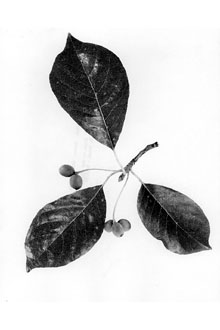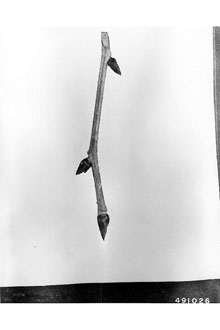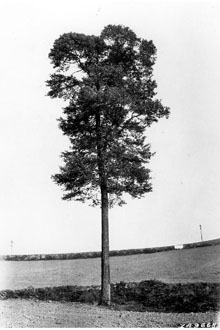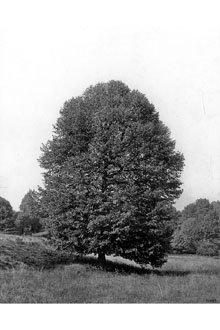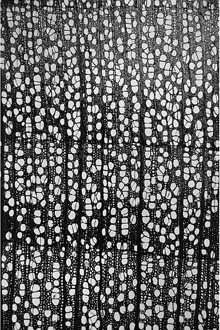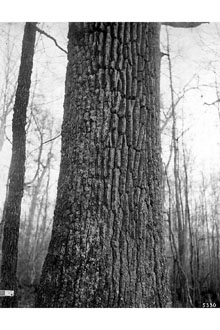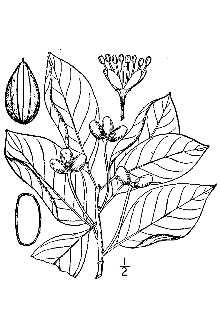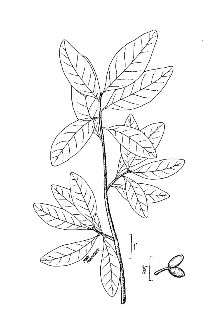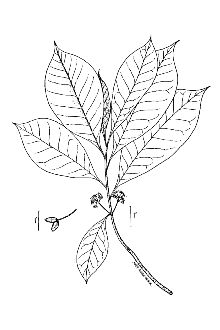Nyssa sylvatica Marshall var. typica Fernald
Scientific Name: Nyssa sylvatica Marshall var. typica Fernald
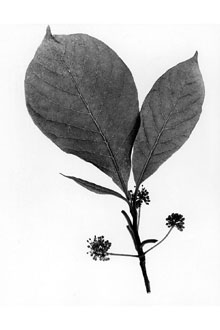
| General Information | |
|---|---|
| Usda Symbol | NYSYT |
| Group | Dicot |
| Life Cycle | Perennial |
| Growth Habits | Tree |
| Native Locations | NYSYT |
Plant Guide
Alternate Names
Black tupelo, blackgum, sour gum, pepperidge, tupelo, and tupelo-gum
Uses
Erosion Control: Reestablishes well in erosion prone areas like burned over forest, abandoned fields, rolling hills and cold mountain swamps. Wildlife: Black bears, foxes, wood ducks, wild turkeys, robins, woodpeckers, mockingbirds, brown thrashers, thrushes, flickers, and starlings frequently eat the fruit, while white-tailed deer and beavers browse the twigs, foliage, and young sprouts. Additionally, provides cavity and nesting sites for a variety of birds and mammals and a good honey tree. Timber: Its wood is used for light, non-splitting woodwork such as in docks and wharves; veneer, containers, crossties, and pallets. Recreation and Beautification: Excellent ornamental plant for its straight bole, shapely crown and attractive autumn foliage.
Status
Please consult the PLANTS Web site and your State Department of Natural Resources for this plant’s current status, such as, state noxious status and wetland indicator values.
Description
Nyssa sylvatica is a medium to large-sized native tree, frequently 60 to 80 ft tall and 3 to 4 ft in diameter, It typically has dense foliage with a conical crown on straight trunk, The simple, alternate leaves are leathery, and densely clustered at the branchlets, The small greenish white flowers are borne singly or in clusters, The bark is reddish brown and broken into deep irregular ridges and diamond-shaped plates, Distribution: Blackgum grows from Maine west to New York, extreme southern Ontario, central Michigan, Illinois, central Missouri, and south to central Florida, Use soil moisture sensors to measure the soil moisture of Nyssa sylvatica Marshall var. typica Fernald.,
Adaptation
A wide variety of sites have adapted to the Blackgum. They range from the creek bottoms of the southern Coastal Plain to altitudes of 3,000 feet in North Carolina. It grows best on well-drained, light-textured soils on the low ridges of second bottoms and on the high flats of silt alluvium. Blackgum will tolerate brief spring flooding on alluvial sites and is common on the relatively dry upper and middle slopes in the Appalachian Mountains. On the drier uplands, it grows best on loam and clay loam. It is well adapted to fire. Older trees have thick bark and relatively high moisture content. Although aboveground portions of young trees are top-killed by fire, it typically survives by sprouting from the root crown or caudex.
Establishment
Blackgum is usually found in a mix of other species including black cherry (Prunus serotina), dogwood (Cornus florida), hickory (Carya spp.), oak (Quercus Plant Materials <http://plant-materials.nrcs.usda.gov/> Plant Fact Sheet/Guide Coordination Page <http://plant-materials.nrcs.usda.gov/intranet/pfs.html> National Plant Data Center <http://npdc.usda.gov>
Management
Seedling establishment is best accomplished by the shelterwood method. Regeneration can also be accomplished by clear-cutting if prior to a good seed fall or if advanced regeneration already exist. Due to the high palatability of seedlings and sprouts, controlling deer populations can protect Black tupelo. It often competes with loblolly and short-leaf pine for water and light, reducing its growth and development. Basal tree injections with herbicide is an effective control method for crown kill. Intermediate trees respond favorably to release from overhead vegetation; seedlings respond to reduction in canopy cover with relatively rapid height growth.
Pests
Tupelo leaf minors (Antispila nyssaefolia) and forest tent caterpillar (Malacosoma disstria) attacks Black tupelo causing growth loss and occasional mortality. Cultivars, Improved and Selected Materials (and area of origin) Materials are readily available from nurseries throughout its range. Contact your local Natural Resources Conservation Service (formerly Soil Conservation Service) office for more information. Look in the phone book under ”United States Government.” The Natural Resources
Conservation
Service will be listed under the subheading “Department of Agriculture.”
Fact Sheet
Alternate Names
sourgum, pepperidge, tupelo, tupelo-gum
Uses
Erosion Control: Reestablishes well in erosion prone areas like burned over forest, abandoned fields, rolling hills and cold mountain swamps. Wildlife: Black bears, foxes, wood ducks, wild turkeys, robins, woodpeckers, mockingbirds, brown thrashers, thrushes, flickers, and starlings frequently eat the fruit, while white-tailed deer and beavers browse the twigs, foliage and young sprouts. Additionally, provides cavity and nesting sites for a variety of birds and mammals and a good honey tree. Timber: Its wood is used for light, nonsplitting woodwork such as in docks and wharves; veneer, containers, crossties and pallets. Recreation and Beautification: Excellent ornamental plant for its straight bole, shapely crown and attractive autumn foliage.
Status
Please consult the PLANTS Web site and your State Department of Natural Resources for this plant’s current status (e.g. threatened or endangered species, state noxious status, and wetland indicator values).
Description
Nyssa sylvatica Marsh., blackgum, grows from Maine west to New York, extreme southern Ontario, central Michigan, Illinois, central Missouri, and south to central Florida. It is a medium- to large-sized tree, frequently 60 to 80 ft high and 3 to 4 ft in diameter; it typically has dense foliage with a conical crown on a straight trunk. The simple, alternate leaves are leathery, and densely clustered at the branchlets. The small greenish white flowers are borne singly or in clusters. The bark is reddish brown and broken into deep irregular ridges and diamond-shaped plates.
Adaptation and Distribution
Distribution
Distribution
It is adapted to a wide variety of sites, from the creek bottoms of the southern Coastal Plain to altitudes of 3,000 feet in North Carolina, It grows best on well-drained, light-textured soils on the low ridges of second bottoms and on the high flats of silty alluvium, It will tolerate brief spring flooding on alluvial sites and is common on the relatively dry upper and middle slopes in the Appalachian Mountains, Use soil moisture sensors to measure the soil moisture of Nyssa sylvatica Marshall var. typica Fernald., On the drier uplands, it grows best on the loams and clay loams, It is well adapted to fire, Older trees have thick bark and relatively high moisture content, Although aboveground portions of young trees are top-killed by fire, it typically survives by sprouting from the root crown or caudex, Robert H, Mohlenbrock USDA NRCS 1991, Southern Wetland Flora @ USDA NRCS PLANTS Blackgum is distributed throughout the East and lower Midwest, For a current distribution map, please consult the Plant Profile page for this species on the PLANTS Website,
Establishment
Blackgum is usually found with a mix of other species including black cherry (Prunus serotina), dogwood (Cornus florida), hickory (Carya spp.), oak (Quercus spp.), eastern hophornbeam (Ostrya virginiana), and yaupon (Ilex vomitoria), it is shade tolerant and seldom grows as dominant tree but it usually grows in the intermediate crown class on most sites. It responds favorably to release from overtopping vegetation. Seedlings grow slowly under a fully stocked stand. At the time of disturbance large numbers of new seedlings can become established. Smaller blackgum stumps sprout readily and larger stumps sprout and develop root suckers. Layering can be used to produce stocks. Seed production is highly variable, disseminated primarily by gravity and birds, others generally fall to the ground and remain dormant in the litter or are carried by water. Seed overwinters on cool, damp soil and germinates the following spring. It requires nearly full sunlight for optimum early growth. The plant tolerates competition and can exist on unfavorable sites. Pre-chilled seeds must be sown in spring. Seeds are drilled at the rate of 15 per ft of row and covered with ½ - 1 inch of soil. A mulch of sawdust is often used. Beds must be kept moist. It sprouts from the stump following disturbance. Smaller sour gum stumps sprout readily while larger stumps sprout occasionally. Sprouts arise from suppressed buds and are concentrated near the top of the stump. Stump sprouts can produce seeds at 2 years of age.
Management
Seedling establishment is best accomplished by shelterwood method. Regeneration can also be accomplished by clear-cutting if prior to a good seed fall or if advanced regeneration already exist. Due to the high palatability of seedlings and sprouts, blackgum can be protected by controlling deer populations. It often competes with loblolly and shortleaf pine for water and light, reducing its growth and development. Basal tree injections with herbicide is effective control method for crown kill. Intermediate trees respond favorably to release from overhead vegetation; seedlings respond to reduction in canopy cover with relatively rapid height growth.
Plant Traits
Growth Requirements
| Temperature, Minimum (°F) | -18 |
|---|---|
| Adapted to Coarse Textured Soils | Yes |
| Adapted to Fine Textured Soils | No |
| Adapted to Medium Textured Soils | Yes |
| Anaerobic Tolerance | Low |
| CaCO3 Tolerance | None |
| Cold Stratification Required | Yes |
| Drought Tolerance | Low |
| Fertility Requirement | Medium |
| Fire Tolerance | Low |
| Frost Free Days, Minimum | 140 |
| Hedge Tolerance | None |
| Moisture Use | Medium |
| pH, Maximum | 6.0 |
| pH, Minimum | 4.5 |
| Planting Density per Acre, Maxim | 800 |
| Planting Density per Acre, Minim | 400 |
| Precipitation, Maximum | 60 |
| Precipitation, Minimum | 40 |
| Root Depth, Minimum (inches) | 30 |
| Salinity Tolerance | Medium |
| Shade Tolerance | Tolerant |
Morphology/Physiology
| Bloat | None |
|---|---|
| Toxicity | None |
| Resprout Ability | Yes |
| Shape and Orientation | Erect |
| Active Growth Period | Spring and Summer |
| C:N Ratio | High |
| Coppice Potential | Yes |
| Fall Conspicuous | Yes |
| Fire Resistant | No |
| Flower Color | Green |
| Flower Conspicuous | No |
| Foliage Color | Green |
| Foliage Porosity Summer | Dense |
| Foliage Porosity Winter | Porous |
| Foliage Texture | Coarse |
| Fruit/Seed Conspicuous | No |
| Nitrogen Fixation | None |
| Low Growing Grass | No |
| Lifespan | Moderate |
| Leaf Retention | No |
| Known Allelopath | No |
| Height, Mature (feet) | 95.0 |
| Height at 20 Years, Maximum (fee | 30 |
| Growth Rate | Moderate |
| Growth Form | Single Stem |
| Fruit/Seed Color | Blue |
Reproduction
| Vegetative Spread Rate | None |
|---|---|
| Small Grain | No |
| Seedling Vigor | Medium |
| Seed Spread Rate | Slow |
| Fruit/Seed Period End | Fall |
| Seed per Pound | 3360 |
| Propagated by Tubers | No |
| Propagated by Sprigs | No |
| Propagated by Sod | No |
| Propagated by Seed | Yes |
| Propagated by Corm | No |
| Propagated by Container | Yes |
| Propagated by Bulb | No |
| Propagated by Bare Root | Yes |
| Fruit/Seed Persistence | No |
| Fruit/Seed Period Begin | Summer |
| Fruit/Seed Abundance | Medium |
| Commercial Availability | Routinely Available |
| Bloom Period | Late Spring |
| Propagated by Cuttings | Yes |
Suitability/Use
| Veneer Product | No |
|---|---|
| Pulpwood Product | No |
| Post Product | No |
| Palatable Human | No |
| Palatable Browse Animal | Medium |
| Nursery Stock Product | Yes |
| Naval Store Product | No |
| Lumber Product | No |
| Fuelwood Product | Medium |
| Fodder Product | No |
| Christmas Tree Product | No |
| Berry/Nut/Seed Product | No |

